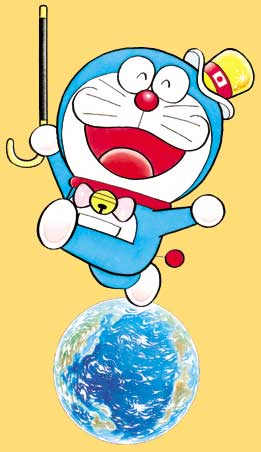This week I’ve put up the 13 pages of “TwinSide”, as well as the assorted bits and pieces. I’ve also been doing a colour wallpaper or two, but won’t be putting it up yet – though my output may slow down a bit because of this.
 Doraemon (Fujimoto Hiroshi and Motoo Abiko)
Doraemon (Fujimoto Hiroshi and Motoo Abiko)
Has been around since 1970
Now for another very, very famous manga you’ll never have heard of if you live in an English-speaking country – Doraemon, the story of a blue robot cat from the future and his human “owner”, Nobita. It’s no exaggeration to say Doraemon is one of the most iconic manga characters of all time – not as famous as Astro Boy or Hello Kitty, but in some countries just as recognisable. Show a picture of him to children in any East Asian country and they instantly know who he is. What seems like zillions of children grew up on this manga and anime series in the 70s, 80s and 90s.
Plot
Since this is a children’s comedy series, the characters remain static, and the plot is relatively simple and episodic. The main character is Nobi Nobita, a fourth-grader who is a failure at everything he does. He is so hopeless his great-grandson from the future has to step in and send him a robot companion, Doraemon. Doraemon is a free-thinking robot with a wide array of futuristic high-tech toys, which he attempts to help Nobita with in everything from passing tests to winning fights with the local bullies. However, as the gentle moralistic nature of children’s stories dictate, the toys are often misused, resulting in a lot of laughs and a few subtle lessons. In the end, everything works out okay – this is a comedy series after all.
Why I recommend this story
I used to dislike this story when I was a teenager – I thought I was too grown-up for “childish” stories. Well, you might as well say “TinTin” is childish. The truth is, children’s stories can be wonderfully entertaining for adults to read, and many have things in them which adults may understand better than the target audience. Doraemon is such a story.
Apart from the endlessly amusing gadgetry and all the goofy ways they are misused, there are also some surprisingly touching scenes in the story. The moral content is subtle and rarely preachy, and the more recent stories have an sociological or environmental bent. This makes it educational and entertaining in the best possible sense, and while children may not necessarily appreciate everything in this series, adults certainly will. I, for one, appreciate the way the author is able to work so much into the material without making it seem pretentious.
Then there is the protagonist Nobita; which works as a point of identification for children, and as a metaphor for the flaws adults sometimes find in themselves. Nobita is one of those archetypical characters that everyone can see something of themselves in. He’s lazy, stupid and cowardly, yet has a kind heart and can be counted to make the right choices at the end of the day. Nobita’s inner battles between his slovenly self and his nobler self is often the driving force of the story.
In the end, Doraemon is a rare gem, and one of the few children’s manga I can recommend to adults. However, be warned: even if you’re able to find an English version of this, it’s a story best read in large batches. Reading one or two stories isn’t going to impress. Needless to say, people looking for sweeping epics better look elsewhere, because the drama in this is defintely small-scale, though no less entertaining.

1 thought on “Recommendation: Doraemon”
Comments are closed.